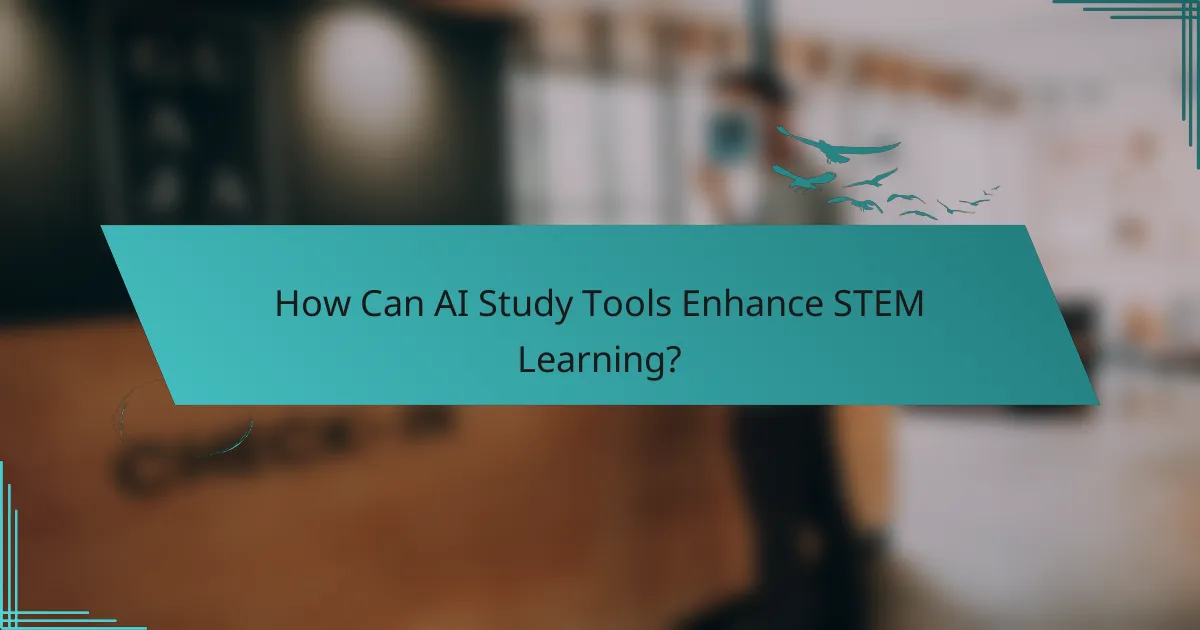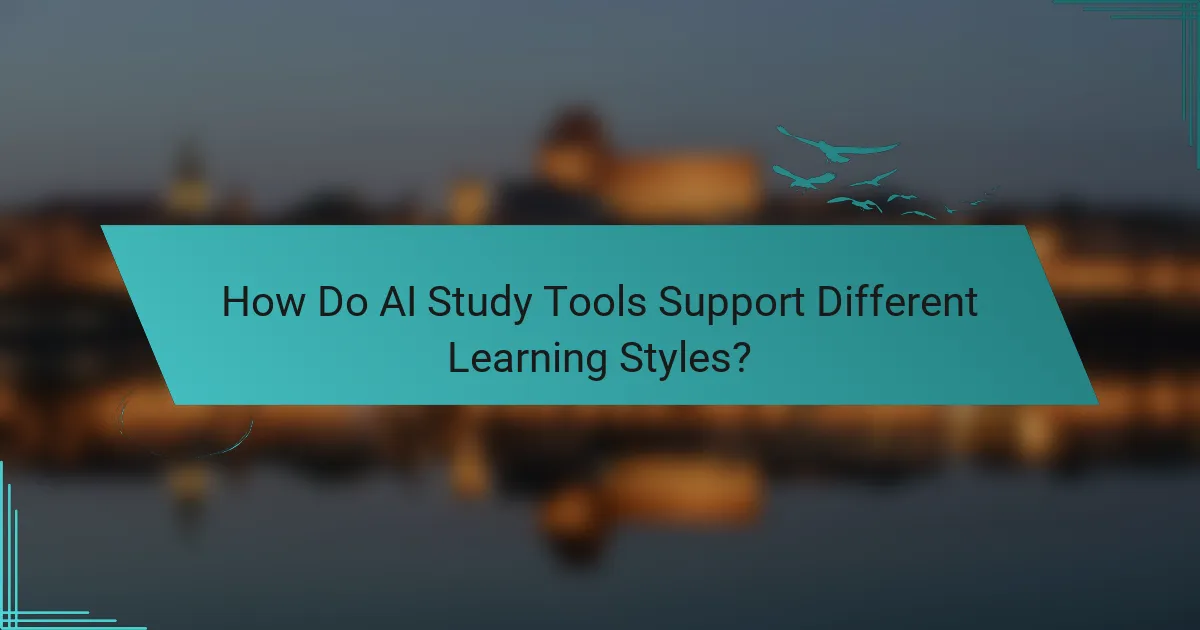AI study tools are revolutionizing STEM education by offering customized learning paths that cater to individual student needs. By utilizing data and algorithms, these tools create personalized experiences that adapt to each learner’s pace and style, enhancing both effectiveness and engagement in subjects like science, technology, engineering, and mathematics.

How Can AI Study Tools Enhance STEM Learning?
AI study tools can significantly enhance STEM learning by providing customized learning paths tailored to individual student needs. These tools leverage data and algorithms to create personalized experiences that adapt to each learner’s pace and style, making education more effective and engaging.
Personalized learning experiences
Personalized learning experiences allow students to engage with STEM subjects in ways that align with their unique interests and strengths. AI tools assess a learner’s performance and preferences, enabling the creation of customized content that targets specific areas for improvement.
For instance, a student struggling with calculus may receive additional resources and practice problems focused on that topic, while another excelling in physics might explore advanced concepts. This tailored approach helps maintain motivation and fosters a deeper understanding of the material.
Adaptive assessments
Adaptive assessments adjust the difficulty of questions based on a student’s responses, providing a more accurate measure of their knowledge and skills. This dynamic testing method ensures that students are neither overwhelmed by too difficult questions nor bored by those that are too easy.
For example, if a student answers several algebra questions correctly, the assessment will present more challenging problems, while incorrect answers will lead to simpler questions. This adaptability helps identify knowledge gaps and reinforces learning effectively.
Real-time feedback mechanisms
Real-time feedback mechanisms provide immediate responses to student inputs, allowing learners to understand their mistakes and correct them on the spot. This instant feedback loop is crucial in STEM education, where concepts often build on one another.
For example, if a student submits a solution to a physics problem, the AI tool can highlight errors and suggest alternative approaches right away. This timely intervention helps students grasp concepts more firmly and reduces the chances of misconceptions persisting.
Data-driven insights for educators
Data-driven insights equip educators with valuable information about student performance and learning trends. By analyzing data collected from AI tools, teachers can identify which topics are challenging for their students and adjust their instruction accordingly.
For instance, if a significant number of students struggle with a particular concept in chemistry, the educator can revisit that topic with targeted lessons or additional resources. This data-centric approach enhances teaching effectiveness and supports student success in STEM disciplines.

Which AI Study Tools Are Best for STEM Education?
Several AI study tools stand out for their effectiveness in STEM education, offering tailored learning experiences. Key platforms include Khan Academy, Coursera, Edmodo, and Quizlet, each providing unique features to enhance understanding and retention in science, technology, engineering, and mathematics.
Khan Academy
Khan Academy is a free online resource that offers a wide range of courses in STEM subjects. Its personalized learning dashboard allows students to progress at their own pace, with interactive exercises and instructional videos tailored to individual needs.
Students can track their progress and receive instant feedback, which helps identify areas needing improvement. The platform covers topics from basic math to advanced physics, making it suitable for learners of all levels.
Coursera
Coursera partners with top universities and organizations to provide high-quality courses in STEM fields. Users can access a variety of courses, from introductory to advanced levels, often with options for certification.
Many courses include video lectures, peer-reviewed assignments, and community discussion forums, enhancing the learning experience. While some courses are free, others may require payment, typically ranging from $30 to $100, depending on the course and institution.
Edmodo
Edmodo is a social learning platform designed for teachers and students, facilitating collaboration in STEM education. It allows educators to create customized learning paths and share resources, assignments, and quizzes with their students.
With features like class discussions and polls, Edmodo fosters a community learning environment. Teachers can monitor student progress and engagement, which helps in adjusting teaching methods to meet diverse learning needs.
Quizlet
Quizlet is a versatile study tool that enables students to create and share flashcards, quizzes, and games for various STEM topics. Its AI-driven features help personalize study sessions based on individual performance.
Students can access millions of user-generated study sets or create their own, making it easy to focus on specific areas. The platform is particularly effective for memorization and quick revision, with options for different learning styles, such as visual aids and interactive games.

What Features Should You Look for in AI Study Tools?
When selecting AI study tools for STEM education, prioritize features that enhance personalized learning experiences. Look for tools that offer customizable learning paths, integrate seamlessly with existing curricula, and provide user-friendly interfaces to ensure effective engagement and comprehension.
Customizable learning paths
Customizable learning paths allow students to tailor their educational journey based on their individual strengths and weaknesses. These paths adapt to the learner’s pace, providing targeted resources and assessments that align with their specific needs. For example, a student struggling with calculus might receive additional practice problems and tutorials focused on that topic.
When evaluating tools, consider those that offer flexibility in content selection and pacing. A good AI study tool should enable learners to set goals and adjust their learning trajectory as they progress, ensuring a more personalized and effective learning experience.
Integration with existing curricula
AI study tools should seamlessly integrate with existing STEM curricula to enhance the learning experience without disrupting established teaching methods. This integration allows educators to utilize AI resources alongside traditional materials, making it easier to track student progress and outcomes. Look for tools that align with common educational standards, such as Next Generation Science Standards (NGSS) in the U.S.
Ensure that the AI tool you choose can import and export data easily, allowing for smooth collaboration between teachers and students. This capability helps maintain continuity in learning and supports the use of AI as a supplementary resource rather than a standalone solution.
User-friendly interfaces
A user-friendly interface is crucial for ensuring that students can navigate AI study tools effectively. The design should be intuitive, with clear instructions and accessible features that cater to various learning styles. For instance, visual learners might benefit from interactive simulations, while others may prefer text-based explanations.
When assessing user interfaces, consider tools that offer customization options for layout and accessibility features, such as text-to-speech or adjustable font sizes. A straightforward interface reduces cognitive load, allowing students to focus on learning rather than struggling with technology.

How Do AI Study Tools Support Different Learning Styles?
AI study tools enhance education by catering to various learning styles, enabling personalized experiences that improve comprehension and retention. By adapting content delivery to visual, auditory, and kinesthetic preferences, these tools make STEM subjects more accessible and engaging for all students.
Visual learning aids
Visual learning aids, such as infographics and videos, help students grasp complex concepts by presenting information in a visually appealing manner. AI tools can analyze a learner’s preferences and suggest tailored visual resources that align with their understanding.
For example, a student struggling with geometry might benefit from interactive diagrams that allow them to manipulate shapes. This approach not only reinforces learning but also caters to those who retain information better through visual means.
Interactive simulations
Interactive simulations provide hands-on experiences that allow students to experiment and explore scientific principles in a virtual environment. AI study tools can create customized simulations based on a learner’s progress and areas of difficulty, enhancing engagement and understanding.
For instance, a physics student could use a simulation to visualize forces acting on an object, adjusting variables to see real-time effects. This method encourages active participation and deepens comprehension of abstract concepts.
Collaborative projects
Collaborative projects foster teamwork and communication skills while allowing students to learn from one another. AI tools can facilitate group assignments by matching students with complementary skills and interests, ensuring a balanced workload and diverse perspectives.
For example, a group project on renewable energy could pair students with strengths in research, design, and presentation, leading to a more comprehensive final product. This collaborative approach not only enhances learning but also prepares students for real-world teamwork scenarios.

What Are the Benefits of Using AI Study Tools in STEM?
AI study tools in STEM education offer personalized learning experiences that adapt to individual student needs, enhancing understanding and retention. These tools leverage data analytics to create customized learning paths, making complex subjects more accessible and engaging.
Increased engagement
AI study tools significantly boost student engagement by tailoring content to match their interests and learning styles. This personalization keeps students motivated and encourages active participation in their learning process.
For example, an AI tool might adjust the difficulty of math problems based on a student’s performance, ensuring they are neither overwhelmed nor bored. This adaptive learning approach helps maintain a steady flow of challenges that align with the student’s skill level.
To maximize engagement, educators should encourage students to explore various AI tools and select those that resonate with them. It’s essential to monitor progress and provide feedback to keep students on track and motivated. Avoid relying solely on one tool; a combination can cater to diverse learning preferences.
